Jack and Jill Windmills Society are most grateful to the following for their assistance with our painting project :
John Carpenter, Ian Sloper, Di Lintott, Richard Lillie, Michelle Robinson, Kate Lintott, Gary Congdon, Paul Cutts, Samantha Davies, Roger French, Bernard Gasson, Paul Goodwin, Rory Graves, Danny Jarmann, Sophie Longhurst, Paul Lovelock, David Meares, Sue Morrissey, Elizabeth Morrissey, Brian Paris, Michael Peat, Simon Potter, Jack Slaughter, Lionel Cole, Janet Slaughter, Janet Thomas, Roy Vass and Cody, our fearless guard dog.
We also wish to acknowledge Mid Sussex District Council for advice & for financial assistance and Ackers Scaffolding for their excellently constructed free-standing scaffold.
Repainting Jill Windmill. A diary of progress.
By David Meares
 PART ONE PART ONE
After a period of seven years, it's time for Jill Mill to have a fresh coat of paint. Having resolved with the site owners (Mid Sussex District Council) all the preparatory planning and safety issues, work started with sheeting down the roof of the roundhouse to prevent it being soiled by either the effects of washing down the mill body or by drips of paint (should there be any) during the repainting.
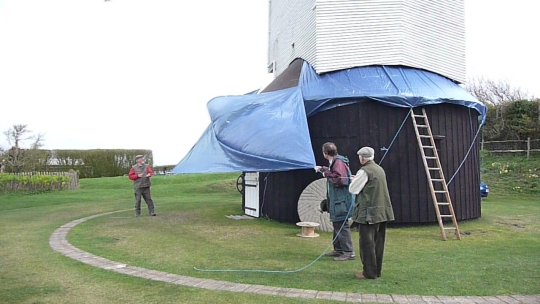
On a modestly breezy day the working group hoist the tarpaulins over the roundhouse roof |
|
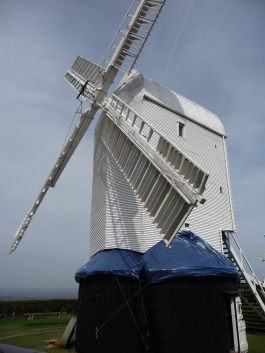
Jill Mill, complete with her temporary blue roof
| 
Some of the PPE arranged in the roundhouse
|
|
Also in preparation for the painting, Personal Protection Equipment (gloves, hard hats, overalls etc) and painting equipment (scrubbing brushes, tooth brushes !?!, paint brushes and paint kettles) had to be acquired / purchased for as many volunteers as might turn up on the same day.
In order to conduct the cleaning and repainting of Jill safely, it is necessary (each time) to scaffold the windmill fully, with working platforms, spaced vertically every 6 feet or so, from which the painting can be carried out. This year, we have engaged the services of Ackers Scaffolding to supply fit and regularly inspect the scaffolding for the duration of the project.
On an unusually balmy Monday, the scaffolders arrived to start their work. Essential to the safely of the scaffold structure, the riggers checked and double checked that all the poles were appropriately vertical or horizontal and that the whole rig was square in plan. With this attention to detail, the first day's work was taken up by the assembly of just the first staging (or lift).

The start of scaffolding
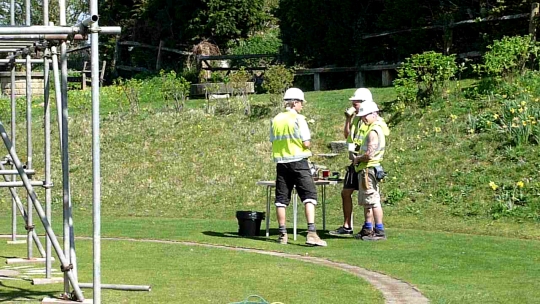
An essential tea-break
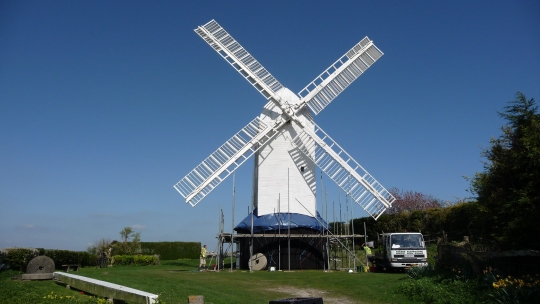
Jill at the end of the first scaffolding day
The following day, the pace speeded up and by the end of day two the scaffolding was up to the second lift, which constituted our first proper working platform.
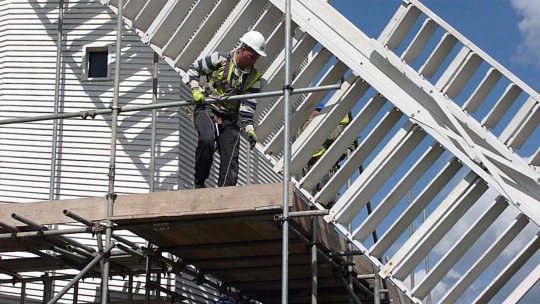
One of the riggers installing the top hand rail. The final arrangement is to be two hand rails per working platform. Note the kick-board as well.
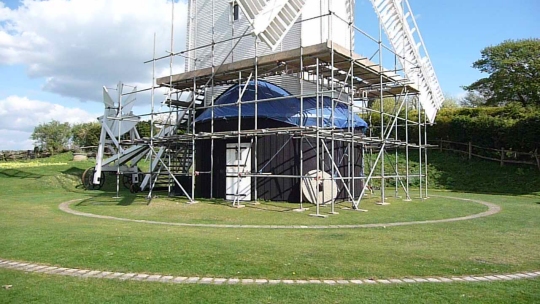
End of day two and the first working platform is complete.
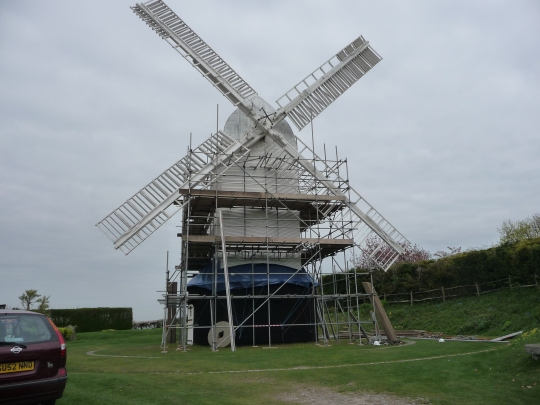
Day three saw the second working platform complete and the start of the fourth lift
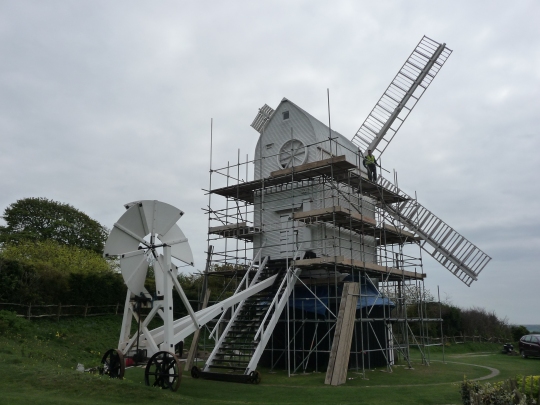
Third platform close to completion. Only one more platform to go !
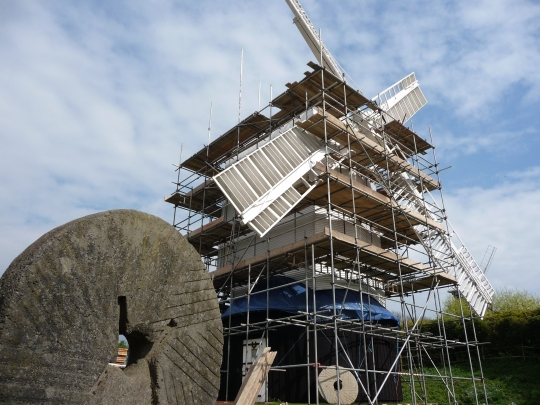
Day five and nearly finished
|
|

The views from the inside . . . | 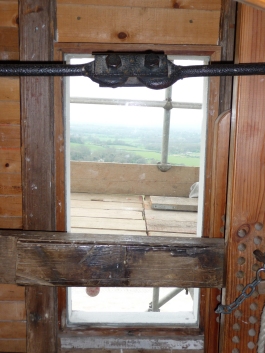
. . . have also changed |
|
 Scaffolding work continued through the rest of the week, which, though chilly and breezy at times, was fortunately free of rain. Scaffolding work continued through the rest of the week, which, though chilly and breezy at times, was fortunately free of rain.
By the end of the Friday, all four working platforms were complete and just the ridge rail and final snagging remained for the Saturday morning, scheduled as our wash-down day. An early start was agreed to minimise any overlapping of activities. |

A new view of Jack
|
|
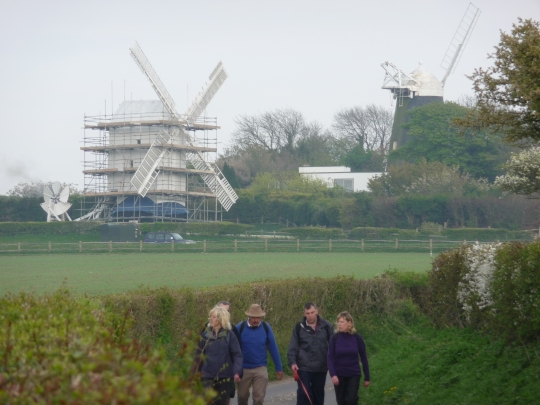
The end of a long week !
|
|

| |
 PART TWO PART TWO
A bright and early start by the scaffolders meant that the remaining construction work was completed by about 10:00 and, with due caution over personal protection, the washing down of the mill started by about 11:00, with the regular Saturday Gang plus additional volunteers. Work continued throughout the day and into the following Saturday, this time with further additional volunteers coming to the aid of the regulars. |
|
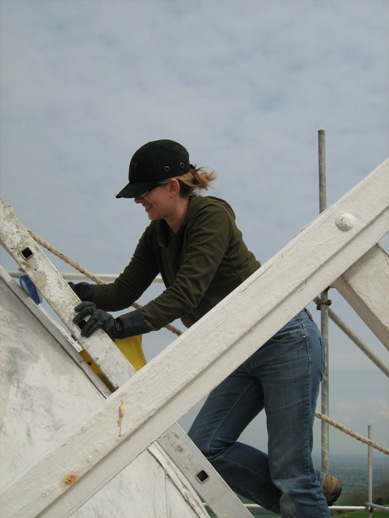
One of the new volunteers braving the heights
|

Where's my horse ? !
|
Fortunately the weather held fair, but it is just as well that the roof was tackled on the first weekend, which was dry but relatively cool, as the weather had taken a turn for the hotter and 26° C on a hot tin roof (OK, metazinc roof) would have been unbearable. As it was, sun block was definitely to the fore on the second wash-down day in order to prevent the volunteers from frying. On that day, wash-down commenced by about 09:00 but the constantly rising temperature meant that by about 15:30 everyone was flagging and shortly thereafter it was decided that we should call an early end to the day, using what remained of our time to clean and secure the site.
|

Many hands make light work
|
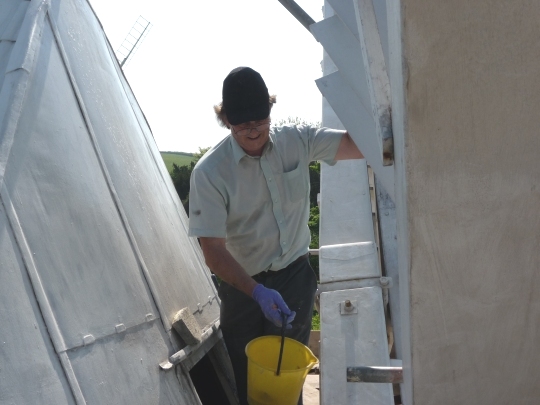
One of the regulars hard at work
|
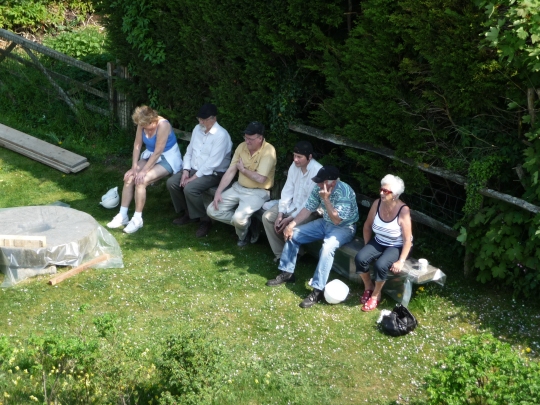
A much needed seat in the shade
|
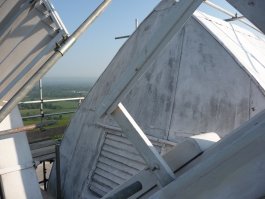
Before and . . .
| 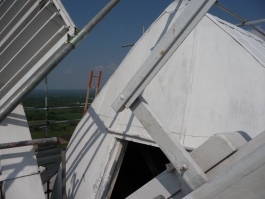
. . . after up at the storm hatch
|

Mother nature at her brightest despite the activities just alongside
|
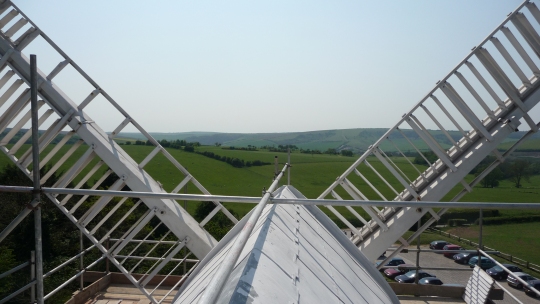
The view from the top is tremendous
|
By the end of the day we had fully washed the roof and both sides of the mill body. Additionally about two thirds of the breast and half of the back had also been cleaned. It is expected that the remainder will take about two hours on the next dry Saturday (many fingers are crossed for continuing dry weather) and then priming and painting will commence. |

| |
| |
| |
 PART THREE PART THREE
It's still sunny - now that is just not typical British weekend weather ! Not that the Jill Mill volunteers complained about it. It was more a case of making the most of it and cracking on with the job in hand. |
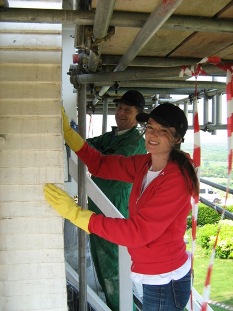
| 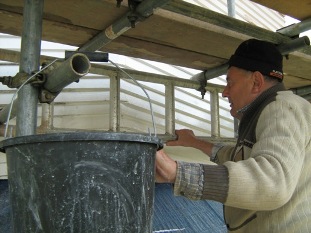
|
Regulars and new volunteers all get stuck into the mill cleaning |
During the day all of the remaining parts of the mill body were washed down and the work commenced of identifying any loose paint and pealing that off prior to painting. This latter snagging activity continued on the following Wednesday and, where paint had been removed from the timber cladding, an initial coat of primer was applied to seal the woodwork. The metazinc roof, however, was a different matter as this needed a special etching primer, which was still awaited. So the roof was left rather patchy. |

| 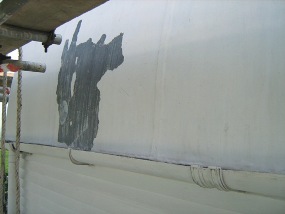 |
Weatherboarding and roof panels after removal of paint where it was flaking off |
 By the end of the day the entire body and roof had been washed down and snagging plus priming had been carried out on all timber surfaces apart from the lower levels of the breast of the mill. By the end of the day the entire body and roof had been washed down and snagging plus priming had been carried out on all timber surfaces apart from the lower levels of the breast of the mill.
The weather forecasts for the following Saturday, were rather dire : offering heavy rain and energetic winds. Fortunately, forecasts are not always correct and, after overnight rain, the precipitation eased off with the last of the light drizzle passing the mill site by about 10:00. Thereafter, it was mixed sunshine and light-ish clouds throughout the day. At ground level it was reasonably calm but at roof level the winds occasionally reached "energetic". This resulted in the mill and the self-supporting scaffold tower moving independently in the wind. Not by much, but when one is scraping and painting the narrow gap between the two, the differential movement can be disconcerting.
As a result of the preparatory work that had been completed on the previous week, the volunteers were able to set to with a vengeance and they both started and completed a first undercoat on the entirety of one long side of the mill body. Roof level to skirting level received their attentions and between them they ensured that at least one side of the mill was starting to look smart again. |
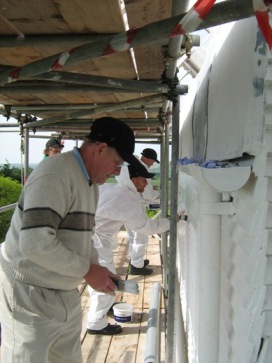
| 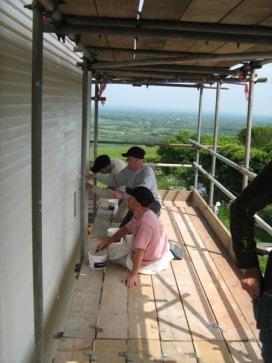 |
The starboard side of the mill (currently facing east) getting a good covering of undercoat paint
|
Elsewhere, however, the old paint was still being attacked to ensure that all lose paint was identified and removed. The body of the mill, apart from the breast and the lower levels of the back, had been done the previous week and so it was these areas that were receiving attention this week. Furthermore, in the case of the breast, probably due to its greater exposure to the wind and weather, much more loose paint was found and removed. |
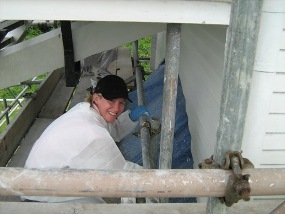
The team hard at work under the steps....
| 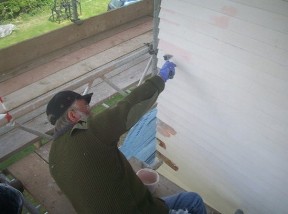
... and on the breast |
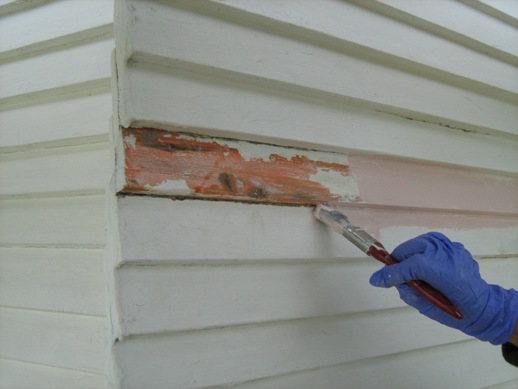
Hey boss ! Are you sure you want this mill painted white ?
Pink is so much prettier
|
 Once again the roof was proving itself to be a little more tricky. Where some loose paint had been removed the previous week, it was found that the edges, thus exposed, had themselves started to lift. As a result, much more of the metazinc panelling had to be stripped and primed, the etching primer having been delivered during the week. Once the loose paint had been teased off, fine wet and dry paper was used to score the metazinc and then the two part primer was mixed and applied. To ensure best possible priming, several coats of primer were applied as each previous coat dried. Once again the roof was proving itself to be a little more tricky. Where some loose paint had been removed the previous week, it was found that the edges, thus exposed, had themselves started to lift. As a result, much more of the metazinc panelling had to be stripped and primed, the etching primer having been delivered during the week. Once the loose paint had been teased off, fine wet and dry paper was used to score the metazinc and then the two part primer was mixed and applied. To ensure best possible priming, several coats of primer were applied as each previous coat dried.
|

Rubbing down the roof panels prior to priming
|
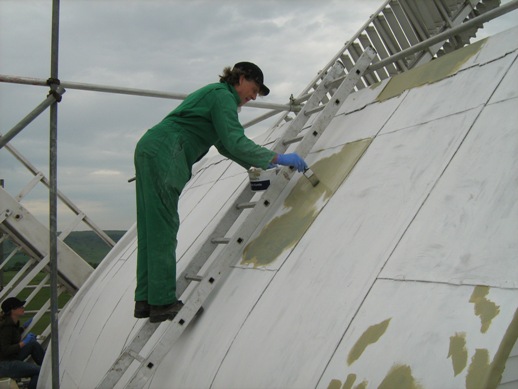
And finally the roof gets its coating of etching primer
|
As would be expected, whilst the mill is covered with scaffolding the opportunity is being taken to fix other problems. This week a cracked section of guttering has been replaced and in a week or two a scarfing repair will have to be made to one of the Sweep uplongs where a shutter bolt had caused the timber to rot. We also want to examine carefully the details around the striking rod and the canister to try to identify if there is an obvious route by which rain water is entering the mill via this assembly. |
| |
 PART FOUR PART FOUR
Again the dire weather forecast was proved wrong. Overnight rain - what overnight rain ? Heavy showers during the day - well, we had one very light shower of short duration half way through the afternoon. So on with the painting.
Having completed the snagging the previous week and primed the exposed surfaces at the same time, the team of Saturday Gang members and new volunteers were able to get on with the undercoat layer.
|

|
For the roof, we just ensured that the pealed and primed areas got a good patching of undercoat. That way we will be able to give the whole roof a thorough undercoat on the next dry Saturday.
|
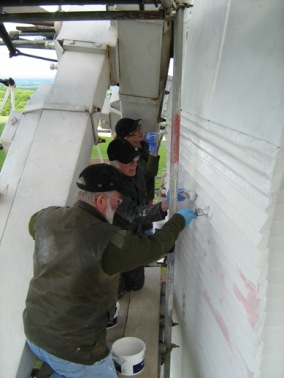
| 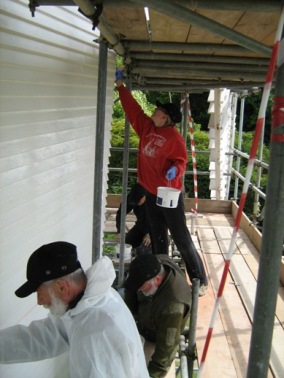
|
The breast, which had previously required a lot of snagging and priming, was given a complete undercoat from roof to skirt. And teamwork ensured that the task made rapid progress.
|
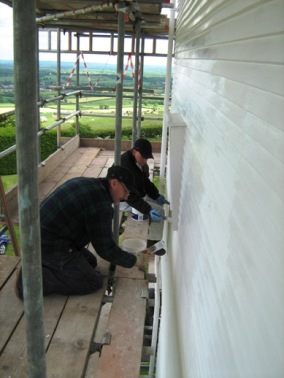
|
In addition, the port side of the mill body was also given a complete undercoat from top to bottom.
|
Finally, with what time we had left, half of the rear face of the mill, including the tricky area around the chain wheel, was also undercoated.
|
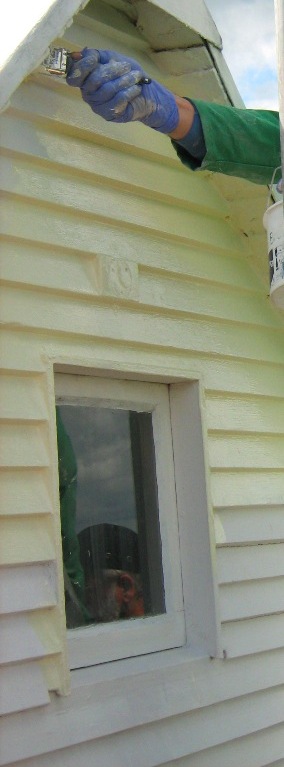
"They called it mellow yellow"
|
As the reader will probably have noticed from the photographs, the different paints (primer and undercoat) have been tinted slightly different colours (at least when we remembered to do so). Last time the mill was painted, it was found to be difficult at times to see what had been painted with the last coat and what had not. 
White on white can be problematic in this sense. To avoid such a problem this year, it was agreed that we should tint the white lead primer pale pink and the white lead undercoat pale yellow. This is proving to be very useful as each week progresses as it is very easy to spot which areas (even small areas) have been covered and which need to be touched up.
|
|
 One week later and the weather turns slightly peculiar. A strong sea breeze for most of the morning brings with it a cold and damp sea mist. Not damp enough to stop our project, but chilly enough to require several layers of clothing and frequent breaks for warm cups of tea. (Well that's our excuse, anyway.) One week later and the weather turns slightly peculiar. A strong sea breeze for most of the morning brings with it a cold and damp sea mist. Not damp enough to stop our project, but chilly enough to require several layers of clothing and frequent breaks for warm cups of tea. (Well that's our excuse, anyway.)
| 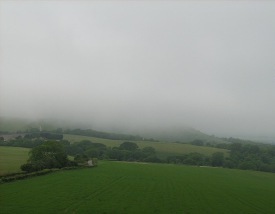
|
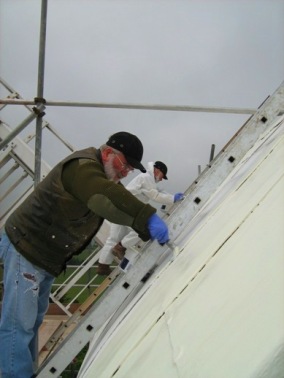
|
The roof, which last week had been patched up with sporadic areas of undercoat, this week received a complete and thorough undercoat.
|

|
The undercoat paint layer on the back of the mill, which was started last week, was completed.
|
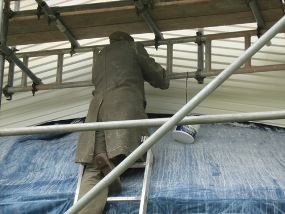
| 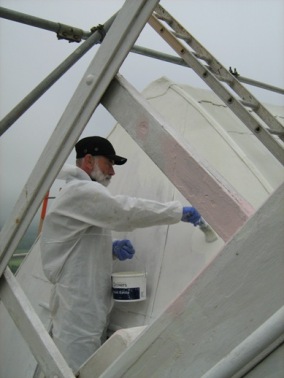
|
Finally, the breast of the mill had its second layer of undercoat. (As the breast is permanently receiving the worst of the prevailing weather, we are giving this face much more attention and extra coats of paint than the rest of the mill body.) |
At this point (and with another cup of tea to hand) the team realised with some satisfaction that we have achieved something of a milestone. The entire mill body has been washed, snagged, primed (where necessary) and undercoated, with double coats being applied where required. All we need now is four more dry Saturdays and we should have finished repainting Jill Windmill !
|

|
|
 PART FIVE PART FIVE
For external painting, one becomes accustomed to responding to the weather and adjusting one's plans accordingly. Such adjustments are usually due to rain of one level of severity or another. The following Saturday required adjustment of plans, not because of rain but because of the wind. Throughout the day the wind remained strong and gusty, to such an extent that it was feared it may be more than the windmill that got painted. Any drip of paint from the roof level of the mill may well, at times, have cleared the back fence before reaching ground level. With that in mind, it was wisely decided to limit the team's efforts to putting a layer of gloss paint on the back of the mill, the only side not exposed to the wind.
|
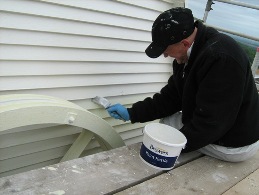

| 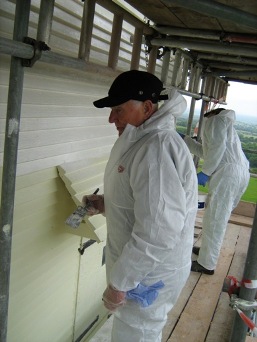
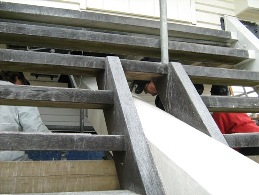
|
Back of Mill getting its gloss coat |
Painting the back of the Mill took all morning, but still the wind was strong and gusty : it might well have been a good milling day, had it not been for the scaffolding. A relaxed lunch was therefore enjoyed, but as the wind was showing no sign of abating it was decided to cease painting for the day.
 The following Monday, being a Bank Holiday, was an ideal opportunity to catch up on lost time. Whilst others enjoyed the day with their families, three hardy regulars turned up at the mill and took stock. Overnight there had been a marked level of condensation from the prevailing mist and the body of the mill was therefore wet / damp. It was felt, however, that the port side was the least damp of the three, so the 'earlier birds' wiped down the woodwork and, by the time the last of the trio arrived, the port side was ready for painting - again gloss paint. Working steadily throughout the morning and the first part of the afternoon, the trio completely painted that side of the mill, from guttering to skirt. A tiring but rewarding day. The following Monday, being a Bank Holiday, was an ideal opportunity to catch up on lost time. Whilst others enjoyed the day with their families, three hardy regulars turned up at the mill and took stock. Overnight there had been a marked level of condensation from the prevailing mist and the body of the mill was therefore wet / damp. It was felt, however, that the port side was the least damp of the three, so the 'earlier birds' wiped down the woodwork and, by the time the last of the trio arrived, the port side was ready for painting - again gloss paint. Working steadily throughout the morning and the first part of the afternoon, the trio completely painted that side of the mill, from guttering to skirt. A tiring but rewarding day.
|
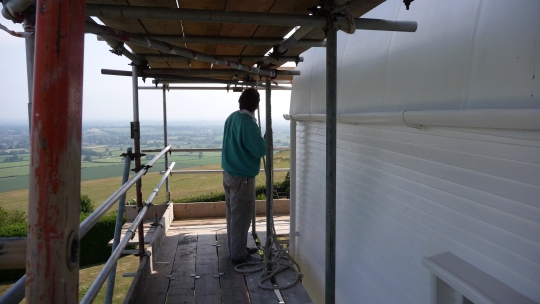
Top of port side starting to look smarter after its gloss coat
|
 Saturday turned out to be both fine (good), warm to hot (still reasonably good) but extremely windy (not so good). If anything it got too windy after lunch and so our activities were again set by the weather. Saturday turned out to be both fine (good), warm to hot (still reasonably good) but extremely windy (not so good). If anything it got too windy after lunch and so our activities were again set by the weather.
|
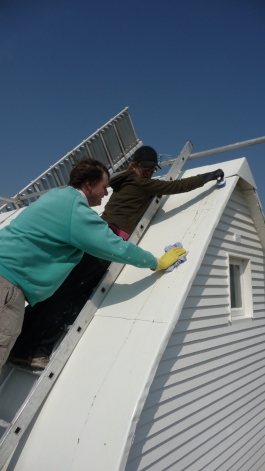
| First things first, the birdie-pooper scoopers had to set to work cleaning the roof before we could start painting.
What is it about a clean white roof that attracts the birds, and what is it that they eat ? Even with a scrubbing brush, the deposits were hard to shift, but shift them we did.
|
And having cleaned it, the team set to and gave the starboard side of the roof its first gloss coat.
In theory, each of those doing the roof painting needed at least three hands. Working off a ladder in gusty winds above the roof, the first hand was needed to hold on to the ladder firmly, the next hand to hold the paint kettle and a third hand to wield the paint brush ! It seems mother nature did not have such activities as this in mind when designing the human body. Nevertheless, by lunchtime half of the roof was looking very smart and the painters were well ready for a break.
| 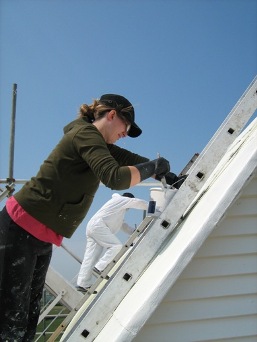
|
After lunch, preparations were made to work on the port side of the roof, but as mentioned earlier the wind had picked up even more strongly than in the morning, and so those preparations were abandoned and the team moved to the breast of the mill which was the only side not being blasted by the wind. Thus the breast got its first coat of gloss paint from the tip of the roof metalwork down to the skirt.
| 
|

| 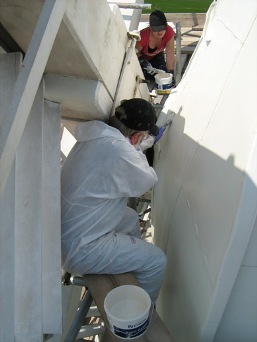
|
 Taking stock at the end of the day, what have we still got to do to finish this project? Taking stock at the end of the day, what have we still got to do to finish this project?
The breast needs a second gloss coat. The port side of the roof needs its coat of gloss paint as does the starboard side of the body. Then the whole roof will need its second coat of gloss. There will need to be a session of touching up the metalwork on the mill door and under the steps with black Hammerite paint, and patching up the paintwork on the sweeps where running repairs have started. Finally we need to try to resolve the ingress of water in the area of the striking rod and to scarf in a replacement section to one of the uplongs where a shutter bolt has allowed water to rot the timber. All-in-all then, a few more weeks of work lie ahead, depending on the weather and the number of volunteers who turn up to assist.
|

|
|
 PART SIX PART SIX
The weather is on our side for once, thus allowing the team of volunteers to make good progress.
|
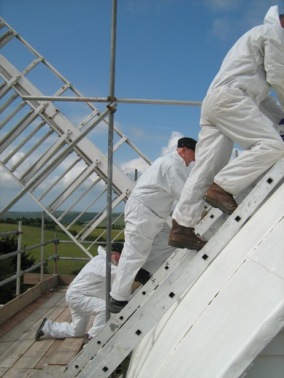
| 
|
With fair weather forecast, we decided early in the day that the roof was to be our main area of activity and so we set to, first cleaning off the bird droppings and then gloss painting. With three volunteers at a time rapid progress was made; the starboard side of the roof getting a second gloss coat and the port side getting its first complete coating.
In the afternoon - the team having spent the lunch break discussing what painting was left to do, how long that might take and when the hail storm would finish - the port side of the mill, which had been sheltered from the storm, got its gloss coat. From guttering down to skirt the complete face was well and truly painted.
|
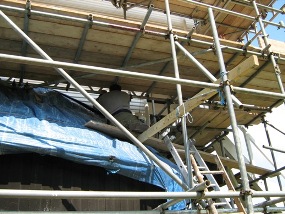
| 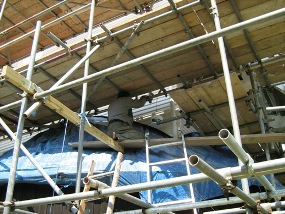
|
Precarious platform ? No way ! |
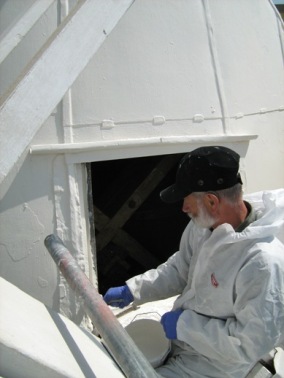
| 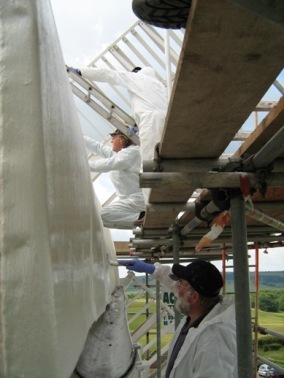
|
Additionally, as there was time and, once more, good weather, the metal-clad areas of the breast were given a second gloss coat.
In one sense, the unsung heroes of this project are the supporting members, who throughout the process have prepared untold numbers of cups of tea and made frequent helpful comments of support, such as
'Oh. I would not have done it that way !'
or
'It might rain on it.'
|
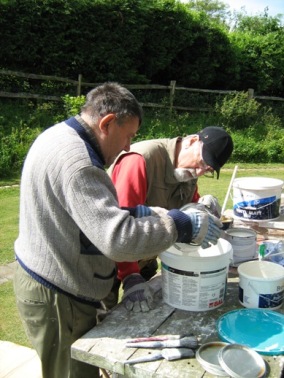

| In this group of supporting members are the ones who are always stirring it - in a literal sense,
i.e. those who are mixing the paint and sending it aloft on the hoist. Without their support, the task would inevitably be taking longer. Keep up the good work !

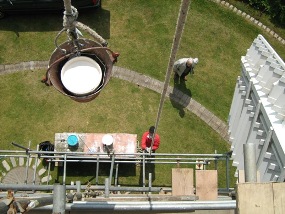
|
After one good Saturday, I guess it was inevitable that there had to be a wet one and the next one turned out to be just so. Strong winds and squally showers severely limited what could be achieved.
The wind was far too strong all morning for anyone to attempt to use a ladder on the top lift in order to paint the port side of the roof. So activities at this level were restricted to giving an extra gloss coat to those areas of the roof which had originally been stripped of their old paint. Even for this, a long handled brush and a good grip on the scaffolding poles were essential.
|

| 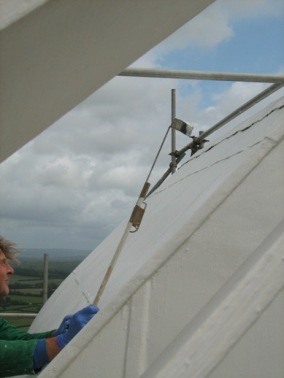
|
The inclement weather also allowed a number of somewhat less immediate tasks to be completed. Clearly during the washing down and painting, a combination of dirt and excess paint had been deposited on the outside of the fixed windows of the mill. The opportunity was therefore taken to scrape these windows clean.
|
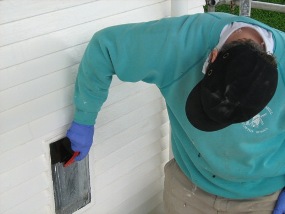
| 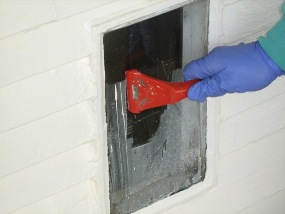
|
Also, to ensure an even colouring of the guttering, one section of which had needed to be replaced, all the guttering was given a further gloss coat.
Finally, more in desperation to make progress than for any other reason, the breast of the mill was given a second coat of gloss paint from the base of the metal-clad area down to the boarding of the first lift. This latter task was interspersed with breaks to shelter from the sporadic bursts of rain and the unavoidable task of drying off areas to be painted.
With this week's weather being so 'ify', next week's tasks will have to include checking of those areas painted this week to ensure the paint has taken.
The lunch break saw no improvement in the weather and so proceedings were brought to a close with the hope that what had been done this week will prove not to have been a waste of time.
|

|
|
 PART SEVEN - ALMOST FINISHED PART SEVEN - ALMOST FINISHED
|
Mother Nature was determined to have her way as rain really 'did stop play'. On the first Saturday in July, however, she smiled on us all, and presented us with a calm, sunny and almost still day, throughout the time we were at the mill. The end product was one of our most productive Saturdays since the project started.
Once more, bird-poo needed to be removed from the roof, and some of the wall areas to be painted needed to be brushed down to remove odd specks of dust and dirt. From then on it was a steady day of clambering over the scaffolding and mill, flexing the brushing arm.
|
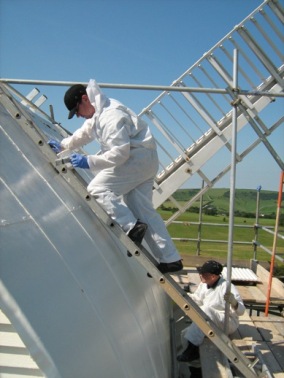
A start was also made on the breast of the mill to ensure that it received a top coat unblemished by watermarks. (Last time's efforts were a bit patchy as a result of the rain showers.)
| The morning saw the port side of the mill's roof getting its second gloss coat and the starboard side getting the odd touch-up where it seemed necessary.
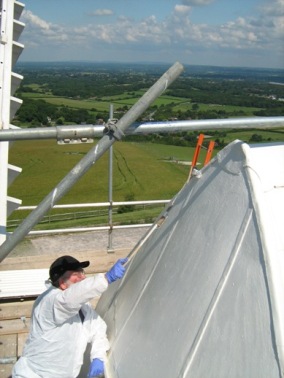
|
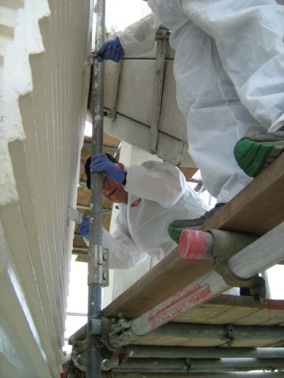
| 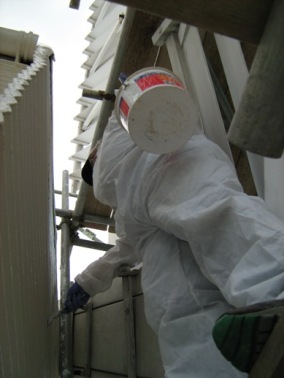
|
After lunch the remainder of the breast and the back of the mill were also given their final gloss coat.
Quite how much paint the painters consumed during the day is not known, but by mid afternoon there was a mad rush by the support team to mix more gloss coat (it tends to settle out in the tins - well, lead is heavy, even in oxide form) as one by one each of the painters ran out of paint in their individual paint kettles.
| 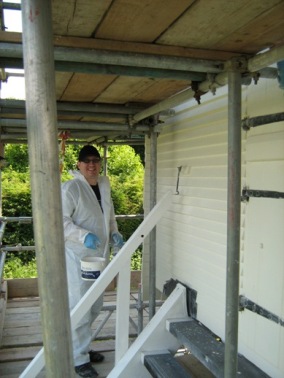
|
In parallel with this other members of the Saturday Gang set to and repaired / replaced the section of the shutter control bar that had rotted through at a bolt-hole. To effect this repair the rotten section was cut out and a fresh section was scarfed in, having been very carefully cut and paired down to the precise measurements required.
Others from the Saturday Gang had a good long look and debate on the vexing question of how, if at all, one could modify the details around the striking rod and the canister to stop rain from gaining access to the body of the mill. Various ideas were considered, but all were rejected as it was felt that we risked trapping rain water as much as stopping its ingress. It seems, therefore that the St George's Board will be retained for the foreseeable future.
|
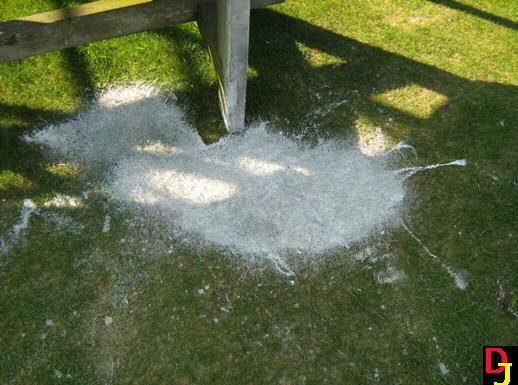
Oops !
|
So with gladdened hearts, at the end of the day we all realised that apart from careful inspection and snagging where necessary on the next fine Saturday, we have successfully completed the painting of the body of Jill Mill for this year. Contact will now be made with the scaffolders to plan the careful dismantling of the scaffolding. This dismantling will be closely supervised to ensure that if any paint is knocked, there will be immediate repair of any damage. All we need is a few more dry days with the scaffolders to achieve, once more, the status of a working windmill.
|

|
|
 PART EIGHT- WHAT GOES UP, MUST COME DOWN PART EIGHT- WHAT GOES UP, MUST COME DOWN
|
With the painting having been finished the previous week, a day was spent preparing the scaffolded mill for the arrival of the scaffolders. Various ladders, boards, hazard warning tapes and ropes all needed to be removed prior to their arrival. Additionally, some of the scaffold poles above roof level were carefully removed to ensure that the paint on the roof would not be at risk when the main scaffold removal work started.
The final aspects of repairing and repainting the shutter control rod were completed such that, as soon as the scaffold was down, we would be able to turn the sweeps and let Jill once more be a working mill. The following Saturday was sadly a wash-out, and so it was not until the following week that the scaffolders arrived on site and started their work.
|
Going . . . . |
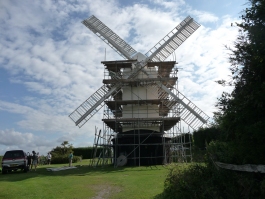
| 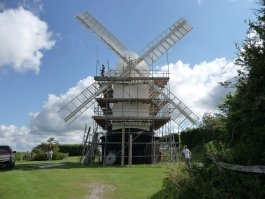
|
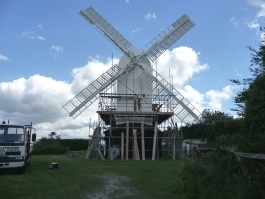
| 
|
By lunch time that day the scaffolding was down to a mere skeleton of poles around the roundhouse and, being a Saturday, the scaffolders do not work after lunch and so the remainder had to wait for another day. | 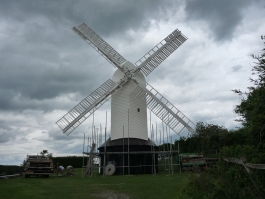
. . . . Going
|
|

|

|
Undaunted, the afternoon was used by the team to continue preparations for once more being able to run the mill. Some members got out the grease and oil, and made sure all the bearings on the fantackle were suitably lubricated. Others started clearing away all the PPE and cleaning the upper floor of the roundhouse.
|
 It was on the Monday that the remaining scaffolding was taken down and removed from site. It was on the Monday that the remaining scaffolding was taken down and removed from site.
|
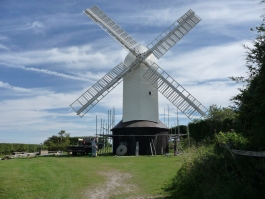
| 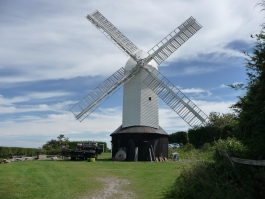
|
|
. . . . Going
|

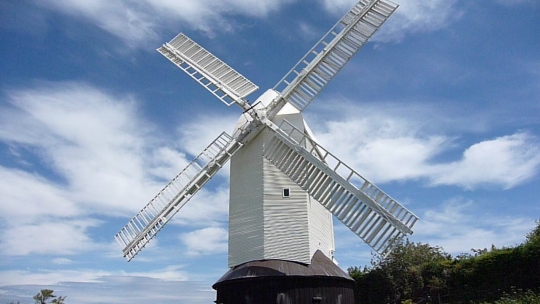
Gone
|
|
Finally, free of constraints, Jill is able to wind herself and we were able to let the sweeps turn for the first time since April.
Not that all the work is yet complete !
The site now needs a thorough cleaning to remove any flakes of old lead paint. The grass needs a modest amount of repair work where scaffold poles and rabbits (and spilt paint) have caused damage. The roundhouse roof and walls need re-tarring and the steps need a good washing down and repainting. The major aspects of repainting Jill are complete, she is free to turn to the wind and, once the site has been cleaned, we will be able once more to welcome visitors to the mill.
|
|
 The roundhouse was painted over the next two Saturdays. The roundhouse was painted over the next two Saturdays.
|
|

|
Report by David Meares
Photographs by Simon Potter, David Meares, Samantha Davies, Gary Congdon and Roger French
|
|